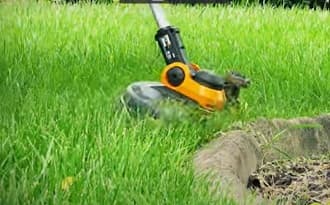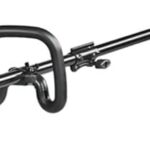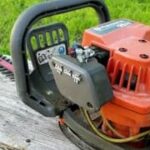As an Amazon Associate, this site earns commissions from qualifying purchases. For more information click here.
It’s a problem I\m sure your familiar with. You start the weed eater, it runs fine but after a few minutes the engine dies out. It can happen suddenly or slowly. Regardless how your trimmer bogs down, I am here to help you fix it so it stays running.
A clogged carburetor is one of the most common reasons why a weed eater starts and suddenly stalls. It could also be due to a dirty air filter, wrong fuel mix or a faulty spark plug.
Dirty Filters and Exhaust
Weed eaters have air filters and exhaust to pull air in and dirt out. The exhaust also has a spark arrestor that catches sparks, an important safety mechanism found in all engines.
The exhaust, spark arrestor and filters accumulate dirt and must be cleaned regularly. These should also be replaced after extensive use.
All of these components are easy to find, clean and replace. Location of these parts will depend on the weed eater so consult the operating instructions.
If you have a new air filter, wipe the dirt off or soak it in soapy water. If the filter is old and torn, replace it. You can do the same with the spark arrestor.
Air filter replacements are widely available. You can buy from the manufacturer or look for third party suppliers that offer compatible air filters.
The weed eater might be also be stalling because the head is damaged or dirty. Either way you have to remove the weed eater head and clean / replace it.

Clean the Carburetor
Turn off your weed eater Wait for the engine to cool down.
Remove the air filter and drain float screws. Lift them off and you should be able to see the carburetor.
Unscrew the carburetor and take it out. Brush and spray dirt, dust and fuel residue off. Clean as thoroughly as possible.
It’s a good idea to clean the carburetor at the end (or start) of each season. To do this I recommend you get the Gumout Cleaner and the Mudder carburetor cleaning kit.
As you do so, look for signs damage or wear and tear. If there is, you’re going to need a carburetor rebuild kit. There are lots available but make certain what you buy is compatible with the trimmer.
Tip: since you have to remove the air filter, might as well clean or replace it. What I do is clean the carburetor along with the air filter and other parts.
Put the carburetor back on. Put everything back and turn the weed eater on. Let the engine run for a few minutes to see if it stalls. If the engine dies out again, you might have to adjust some carburetor settings.
Readjust the Carburetor
Sometimes a weed eater stalls because the carburetor needs some adjustment. Making these adjustments usually solves a lot of engine and fuel related issues.
Adjusting the carburetor requires a bit of tinkering, but it’s pretty straightforward. The procedure is similar across most weed eaters. This video shows you how it works.
Weed eater carburetors have two adjustment screws, marked H and L.
H stands for “high” and controls the fuel setting when the weed eater runs at maximum power.
L stands for “low” and controls fuel consumption when the engine is idle.
Crank the engine and turn the L screw counterclockwise slowly. You only need to make incremental adjustments before you notice the engine slowing.
Remember the screw head position before you turn the screw clockwise. Keep turning until the engine slows.
Repeat the process with the H screw. There is no specific position the adjustment screws have to be in. You have to make adjustments until the engine runs consistently.
Replace the Spark Plug
Next to air filters, spark plugs are the most likely to need cleaning/replacement. Because of how spark plugs work they end up with soot, dirt or break down at some point.
If your weed eater won’t stay running, check the spark plug. Use a tester to verify it’s working. If it’s not, disconnect it.
Replace the spark plug if it is cracked or burned. If it looks fine and just a bit dirty, wipe the soot off. Personally I replace them regularly and don’t wait for it to break. It’s also a good idea to keep a couple in reserve just in case.
Broken Gas Cap
Weed eater tank caps have a hole to let air in. If the hole is blocked, vacuum builds up and the engine will slow or stall.
You can check this out by loosening the cap. If performance improves or the trimmer restarts, you have to fix or replace the cap.
If the cap isn’t broken, you probably put too much fuel. Pour only up to the fill line (this is on the tank), otherwise it could clog the cap.
This is one of the easiest problems to fix and is often overlooked. But if you are new to string trimmers, it is easy to make a mistake when adding fuel. So check the gas cap if there is a problem starting it.
Replace the Fuel Filter
Fuel filters ensure the fuel that goes into the engine is clean, but over time it accumulates gunk. A clogged filter is going to negatively affect the engine so you have to replace it..
Fuel filters are affordable and easy to replace. It is shaped like a cylinder and plugged into a hose connected to the fuel tank. You can find the filter itself inside the fuel tank.
Remove the fuel filter and install a new one. You might have to take the fuel line out as well depending on the model. This video shows you how it is done.
Fuel Problems
There are two common issues that come up, both of which can keep a weed trimmer from running. The first is old fuel, the second is an incorrect fuel mixture.
Old Fuel
If you let gas sit unused for 30 days or longer, it will evaporate and leave a sticky residue behind. This residue is unusable. It also blocks the air filter, carburetor, spark plug etc.
The best way to prevent this is to use a fuel stabilizer. I use Stabil because it is effective and works well with all small engines.
The second method is to empty the fuel tank. Are you going to store the weed eater for winter? You can remove the fuel and not worry about any sticky residue. If you want to leave fuel in it, add a stabilizer.
Wrong Fuel Mix
If you have a 2-stroke weed eater, you have to mix gas and oil according to the instructions. The mix ratio is usually 40:1 or 50:1. Check your instructions for details. If the ratio is incorrect the engine won’t start, or it could start and then stall.
Lack of Fuel
If you’ve been trimming for hours the engine might have simply run out of fuel. Check the tank if there is enough fuel. If you notice it consumes more gas than before, look for leaks in the tank.
If you have to refill, wait for the engine to cool first. Remember that 2-cycle engines require a mix of gas and oil whereas 4-cycle engines store them in separate tanks.
Flooded Engine
There are two ways to fix this. If you have a fuel injected string trimmer, close the choke. To get the fuel moving you have to pull the gas lever. Hold the lever down and crank the engine. This should be enough to un-flood the engine.
If you have a carburetor trimmer, you have to take the air filter out. Next, open the carburetor and turn the string trimmer on. Keep pulling the cord until the engine catches on.
If that doesn’t work, check the carburetor. It might need adjustment, cleaning or both. Also check the air filter if it is dirty and needs replacement. You should also look into the spark plug.

I love the outdoors and all the tools for maintaining gardens, yards and lawns. The only thing I am more passionate about is sharing what I know about garden and outdoor equipment.


